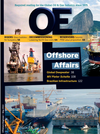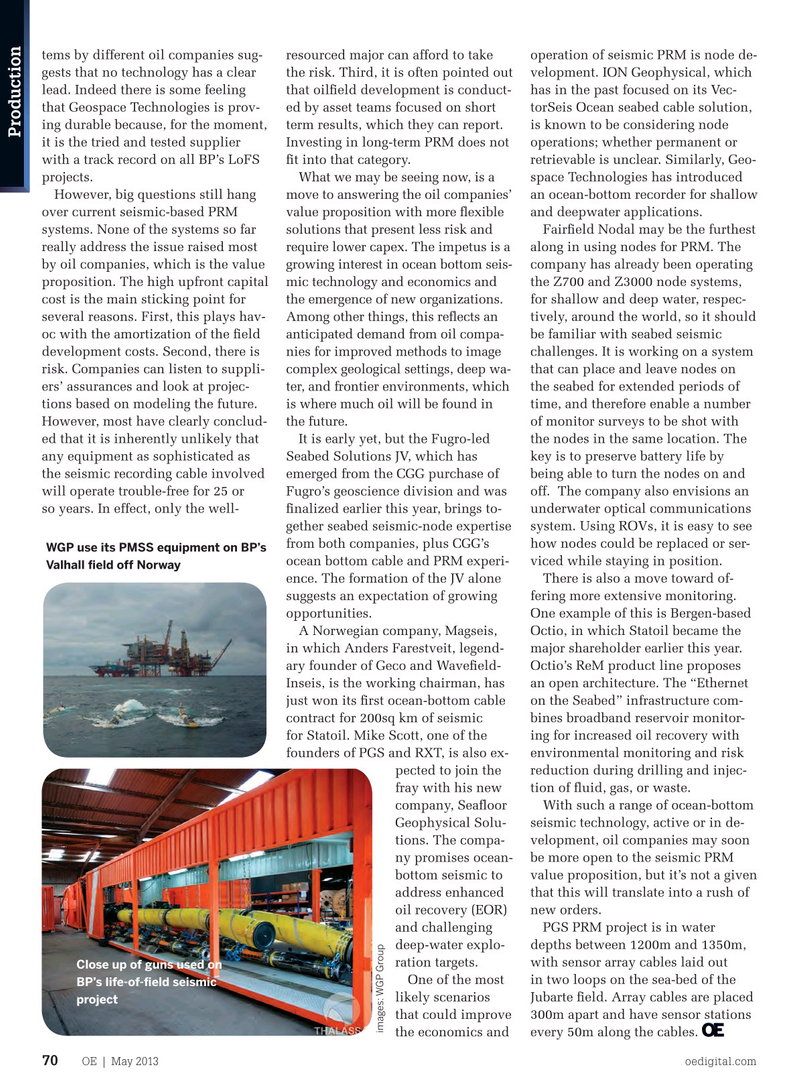
Page 68: of Offshore Engineer Magazine (May/Jun 2013)
Read this page in Pdf, Flash or Html5 edition of May/Jun 2013 Offshore Engineer Magazine
tems by different oil companies sug- resourced major can afford to take operation of seismic PRM is node de- gests that no technology has a clear the risk. Third, it is often pointed out velopment. ION Geophysical, which lead. Indeed there is some feeling that oilfeld development is conduct- has in the past focused on its Vec- that Geospace Technologies is prov- ed by asset teams focused on short torSeis Ocean seabed cable solution, ing durable because, for the moment, term results, which they can report. is known to be considering node
Production it is the tried and tested supplier Investing in long-term PRM does not operations; whether permanent or with a track record on all BP’s LoFS ft into that category. retrievable is unclear. Similarly, Geo- projects. What we may be seeing now, is a space Technologies has introduced
However, big questions still hang move to answering the oil companies’ an ocean-bottom recorder for shallow over current seismic-based PRM value proposition with more fexible and deepwater applications. systems. None of the systems so far solutions that present less risk and Fairfeld Nodal may be the furthest really address the issue raised most require lower capex. The impetus is a along in using nodes for PRM. The by oil companies, which is the value growing interest in ocean bottom seis- company has already been operating proposition. The high upfront capital mic technology and economics and the Z700 and Z3000 node systems, cost is the main sticking point for the emergence of new organizations. for shallow and deep water, respec- several reasons. First, this plays hav- Among other things, this refects an tively, around the world, so it should oc with the amortization of the feld anticipated demand from oil compa- be familiar with seabed seismic development costs. Second, there is nies for improved methods to image challenges. It is working on a system risk. Companies can listen to suppli- complex geological settings, deep wa- that can place and leave nodes on ers’ assurances and look at projec- ter, and frontier environments, which the seabed for extended periods of tions based on modeling the future. is where much oil will be found in time, and therefore enable a number
However, most have clearly conclud- the future. of monitor surveys to be shot with ed that it is inherently unlikely that It is early yet, but the Fugro-led the nodes in the same location. The any equipment as sophisticated as Seabed Solutions JV, which has key is to preserve battery life by the seismic recording cable involved emerged from the CGG purchase of being able to turn the nodes on and will operate trouble-free for 25 or Fugro’s geoscience division and was off. The company also envisions an so years. In effect, only the well- fnalized earlier this year, brings to- underwater optical communications gether seabed seismic-node expertise system. Using ROVs, it is easy to see from both companies, plus CGG’s how nodes could be replaced or ser-
WGP use its PMSS equipment on BP’s ocean bottom cable and PRM experi- viced while staying in position.
Valhall feld off Norway ence. The formation of the JV alone There is also a move toward of- suggests an expectation of growing fering more extensive monitoring. opportunities. One example of this is Bergen-based
A Norwegian company, Magseis, Octio, in which Statoil became the in which Anders Farestveit, legend- major shareholder earlier this year. ary founder of Geco and Wavefeld- Octio’s ReM product line proposes
Inseis, is the working chairman, has an open architecture. The “Ethernet just won its frst ocean-bottom cable on the Seabed” infrastructure com- contract for 200sq km of seismic bines broadband reservoir monitor- for Statoil. Mike Scott, one of the ing for increased oil recovery with founders of PGS and RXT, is also ex- environmental monitoring and risk pected to join the reduction during drilling and injec- fray with his new tion of fuid, gas, or waste. company, Seafoor With such a range of ocean-bottom
Geophysical Solu- seismic technology, active or in de- tions. The compa- velopment, oil companies may soon ny promises ocean- be more open to the seismic PRM bottom seismic to value proposition, but it’s not a given address enhanced that this will translate into a rush of oil recovery (EOR) new orders.
and challenging PGS PRM project is in water deep-water explo- depths between 1200m and 1350m, ration targets. with sensor array cables laid out
Close up of guns used on
One of the most in two loops on the sea-bed of the
BP’s life-of-feld seismic likely scenarios Jubarte feld. Array cables are placed project that could improve 300m apart and have sensor stations images: WGP Group the economics and every 50m along the cables.
OE | May 2013 oedigital.com 70
ProdOps1.indd 70 4/22/13 5:01 PM

 67
67

 69
69